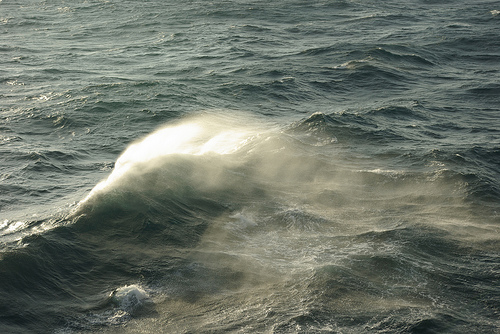When I first read “Spindrift,” it caught me off-guard. The first thing that struck me first about the poem is its (Emily) Dickinsonian style: seemingly random, mid-sentence capitalizations, the hyphens, the brevity. The tone, however, is a bit more hopeful, more reverent as the poet’s mind reaches through the sea spray, contemplating redemption, contemplating God.
The opening image, punctuated as it is by alliteration, is especially striking, setting the stage for the rest of the poem: “Harpooning–the Undoubtable / Shot from your sea-swept eyes, / Frothing mouths– / Bobbing, billowing / On the world’s flood tide” (lines 1-5). I take this Undoubtable stare of the sea to be the gaze of God shooting, harpoon-like, from the windswept waves. This “spindrift” (6) cuts to the marrow with its chilling mist, its clarifying ambiguity. Divine paradox this, that the “good news” (6) often comes to us most clearly, often catches us with its barb, in the moments when we’re wading (faithfully, perhaps) into the darkness of the unknown. I think of Lehi wandering through the mist of darkness before an angel parted the black veil and led him to the Tree of Life. I think of Boyd K. Packer’s commentary on “the leap of faith”: “the moment when you have gone to the edge of the light and stepped into the darkness to discover that the way is lighted ahead for just a footstep or two.” I think of the piercing insights that sometimes come through the disorder of sleep.
While these piercings may at times wound us, they also, I think, mark us (as we approach Christ) as the fruits of His wounded body, leaving their imprint on the soul, a place where the “tissue thickens, binds / Fast-barnacled hooks / Of scarring Divine” (18-20) that tells us we’re God’s, that labels us heirs of His Being, of His Place. Maybe such Divine scars are part of what it means to have His image engraved upon our countenances.
Just maybe.

